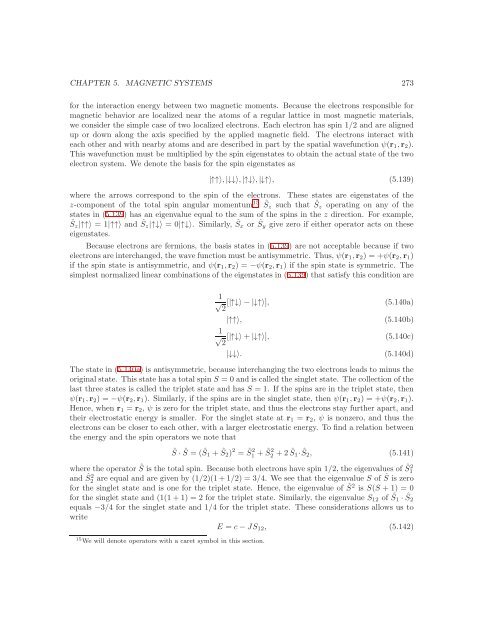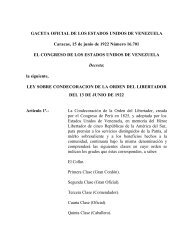Chapter 5 - WebRing
Chapter 5 - WebRing
Chapter 5 - WebRing
You also want an ePaper? Increase the reach of your titles
YUMPU automatically turns print PDFs into web optimized ePapers that Google loves.
CHAPTER 5. MAGNETIC SYSTEMS 273<br />
for the interaction energy between two magnetic moments. Because the electrons responsible for<br />
magnetic behavior are localized near the atoms of a regular lattice in most magnetic materials,<br />
we consider the simple case of two localized electrons. Each electron has spin 1/2 and are aligned<br />
up or down along the axis specified by the applied magnetic field. The electrons interact with<br />
each other and with nearby atoms and are described in part by the spatial wavefunction ψ(r1,r2).<br />
This wavefunction must be multiplied by the spin eigenstates to obtain the actual state of the two<br />
electron system. We denote the basis for the spin eigenstates as<br />
|↑↑〉,|↓↓〉,|↑↓〉,|↓↑〉, (5.139)<br />
where the arrows correspond to the spin of the electrons. These states are eigenstates of the<br />
z-component of the total spin angular momentum 15 ˆ Sz such that ˆ Sz operating on any of the<br />
states in (5.139) has an eigenvalue equal to the sum of the spins in the z direction. For example,<br />
ˆSz|↑↑〉 = 1|↑↑〉 and ˆ Sz|↑↓〉 = 0|↑↓〉. Similarly, ˆ Sx or ˆ Sy give zero if either operator acts on these<br />
eigenstates.<br />
Because electrons are fermions, the basis states in (5.139) are not acceptable because if two<br />
electrons areinterchanged, the wavefunction must be antisymmetric. Thus, ψ(r1,r2) = +ψ(r2,r1)<br />
if the spin state is antisymmetric, and ψ(r1,r2) = −ψ(r2,r1) if the spin state is symmetric. The<br />
simplest normalized linear combinations of the eigenstates in (5.139) that satisfy this condition are<br />
1<br />
√ 2 [|↑↓〉−|↓↑〉], (5.140a)<br />
|↑↑〉, (5.140b)<br />
1<br />
√ [|↑↓〉+|↓↑〉],<br />
2<br />
(5.140c)<br />
|↓↓〉. (5.140d)<br />
The state in (5.140a) is antisymmetric, because interchanging the two electrons leads to minus the<br />
original state. This state has a total spin S = 0 and is called the singlet state. The collection of the<br />
last three states is called the triplet state and has S = 1. If the spins are in the triplet state, then<br />
ψ(r1,r2) = −ψ(r2,r1). Similarly, if the spins are in the singlet state, then ψ(r1,r2) = +ψ(r2,r1).<br />
Hence, when r1 = r2, ψ is zero for the triplet state, and thus the electrons stay further apart, and<br />
their electrostatic energy is smaller. For the singlet state at r1 = r2, ψ is nonzero, and thus the<br />
electrons can be closer to each other, with a larger electrostatic energy. To find a relation between<br />
the energy and the spin operators we note that<br />
ˆS · ˆ S = ( ˆ S1 + ˆ S2) 2 = ˆ S 2 1 + ˆ S 2 2 +2 ˆ S1· ˆ S2, (5.141)<br />
where the operator ˆ S is the total spin. Because both electrons have spin 1/2, the eigenvalues of ˆ S 2 1<br />
and ˆ S 2 2 are equal and are given by (1/2)(1+1/2) = 3/4. We see that the eigenvalue S of ˆ S is zero<br />
for the singlet state and is one for the triplet state. Hence, the eigenvalue of ˆ S 2 is S(S +1) = 0<br />
for the singlet state and (1(1+1) = 2 for the triplet state. Similarly, the eigenvalue S12 of ˆ S1 · ˆ S2<br />
equals −3/4 for the singlet state and 1/4 for the triplet state. These considerations allows us to<br />
write<br />
E = c−JS12, (5.142)<br />
15 We will denote operators with a caret symbol in this section.

















